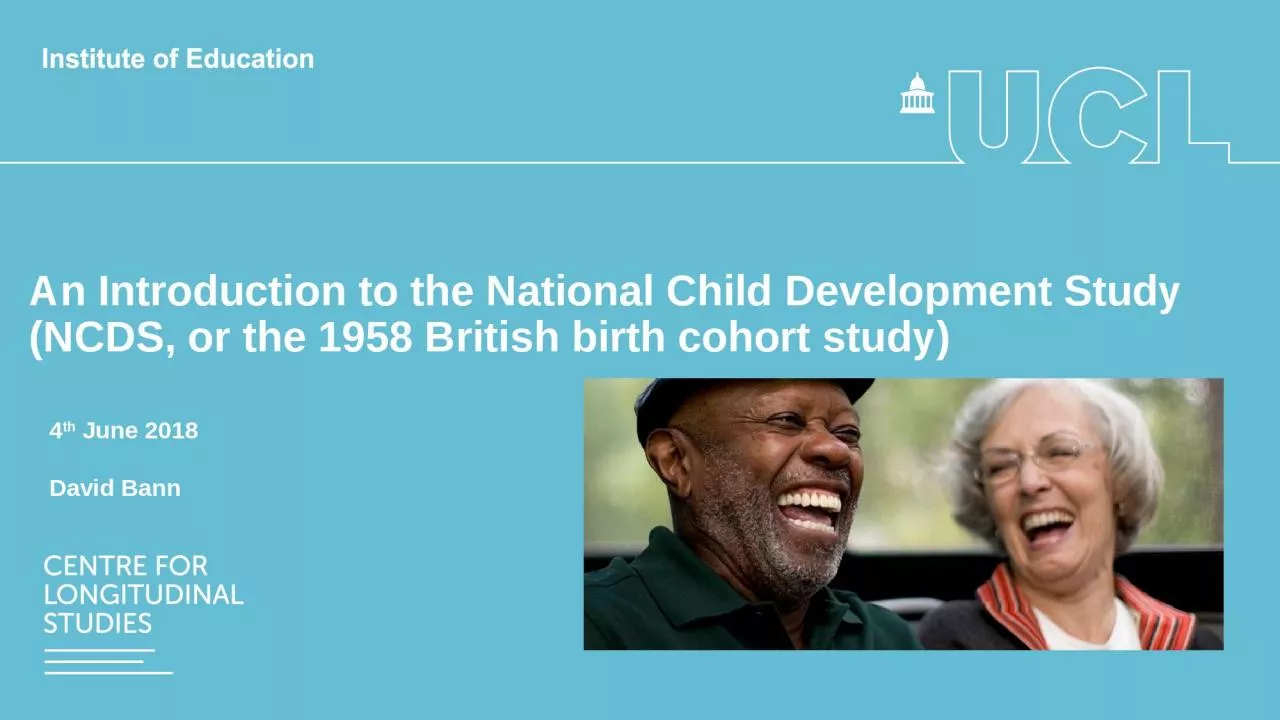

4 th June 2018 David Bann Brief overview of NCDS Longitudinal birth cohort study of all babies born in a single week in GB N17415 Repeated followups from birth to 55y High retention gt9k in recent sweeps ID: 930649
Download Presentation The PPT/PDF document "An Introduction to the National Child De..." is the property of its rightful owner. Permission is granted to download and print the materials on this web site for personal, non-commercial use only, and to display it on your personal computer provided you do not modify the materials and that you retain all copyright notices contained in the materials. By downloading content from our website, you accept the terms of this agreement.
Slide1
An Introduction to the National Child Development Study (NCDS, or the 1958 British birth cohort study)
4th June 2018David Bann
Slide2Brief overview of NCDS
Longitudinal birth cohort study of all babies born in a single week in GB, N=17,415
Repeated follow-ups from birth to 55y
High retention, >9k in recent sweeps
(study in touch with 12.5k)
Multidisciplinary content spanning social and biomedical
PI: Alissa Goodman
Co-Is: David Bann, Gabriella
Conti
Lead study manager: Matt
Brown
Slide3Long term effects of early life circumstancesIntergenerational transmission of advantage and disadvantage and the processes involvedReturns to choices and investments made across lifeDrivers & consequences of life trajectories – health, SES, family
Cross-cohort comparative research eg, social mobility, health inequalityScientific questions and contribution of NCDS
Slide4Scientific contribution of NCDS - metrics2,481publications
1,172average downloads per year from UKDS
974
publications from biomedical sweep
2,429
applications for genetic data from WTCCC
Slide5http://www.cls.ioe.ac.uk/ncds
Slides online, keynotes
Barbara Maughan,
Richard Blundell
Up to 46y only
Slide61958
1965
1969
1974
1981
1991
2000
2003
2004
2008
2013
Birth
7
11
16
23
33
42
44/45
46
50
55
17,415
15,425
15,337
14,654
12,537
11,46911,4199,3779,5349,7909,137
NCDS study timeline
1978 - collection of examination entry and performance details
Mother and Child Survey – a sample of 1 in 3 cohort member
(cog,
beh
)
Consent for record linkages
2002/3 biomedical data collection
First web
data collection
(mixed mode)
Slide71958
1965
1969
1974
1981
1991
2000
2003
2004
2008
2013
Birth
7
11
16
23
33
42
45
46
50
55
mother
parents
parents
cohort
member /
parentssubjectsubjectsubjectsubjectsubjectsubject
subject
medical
medical / school
medical / school
medical / school
partner mother children
cognitive assess-
ments
cognitive assess-
ments
cognitive assess-
ments
cognitive assess-
ments
area
of residence (census)
area of residence
(census)
17,415
15,425
15,337
14,654
12,537
11,469
11,419
9,377
9,534
9,790
9,137
main respondent
secondary respondent
survey instruments
linked data
response rate
NCDS 58
A study of everyone born in one week in 1958
In 1965, 1969 and 1974 the cohort was augmented by the addition of immigrants to Britain who were born in the target week in 1958
Slide8Birth
School years
Adult
Family
Parental employment
Obstetric history
Smoking in pregnancy
Pregnancy
(problems,
antenatal care)
Labour
(length, pain relief, problems)
Birth
(problems, weight, gest age)
Family
Parental employment
Financial circumstances
School
Housing
Views and expectations
Attainment
Health
Behaviour
Cognition
Family
(partners, children)EmploymentIncomeHousingCourses and qualificationsBasic skillsViews and expectationsHealthHealth-related behaviourCognitionTopics covered by life stage
Slide9Age 7
Age 11
Age 16
Southgate Reading Test
Copying Designs Test
Draw-a-man Test
Problem Arithmetic Test
Reading comprehension test
Mathematics comprehension Test
NFER General Ability Test (Douglas, 1964)
Copying-designs Test
Reading comprehension
Mathematics comprehension
Childhood cognition
age
See also childhood ‘non-cog’ (socioemotional skills)
childhood psychological factors etc
Slide10Age 44/5 biomedical sweep
Approximately 9,000 study members took part at age 44/5 (2002/3)
Biosamples
: blood, saliva
Blood pressure, pulse
Standing and sitting height
Weight, waist and hip circumferences
Respiratory symptoms,
ventilatory
function (FEV1 and FVC)
Visual acuity (near and distant), refractive error
Hearing thresholds
Depression and anxiety disorder (CIS-R)
Chronic widespread pain
Use of medications
Alcohol use (AUDIT)
Food
frequency
questionnaire,
exercise
Early & late morning saliva cortisol
Glycosylated haemoglobin fibrinogen
Tissue plasminogen activator
Von
Willebrand
factor
C-reactive protein
Triglycerides Total and HDL cholesterol Total and allergen-specific immunoglobulin E Insulin-like growth factor 1 Vitamin D DNALymphoblastoid cell linesGenetic dataEpigenetic data (N=240+300 underway)
Slide11Access to genetic data and biological samples via META-DAC
Genetic data:
use in phenotype/genotype linkage (
eg
, GWAS, Mendelian randomisation).
Biological samples: apply to further assay whole blood, serum, saliva at 44/45y
metadac.ac.uk/1958bc-resource-types/
Slide12Record linkages in NCDS
Cohort member and partner consent (age 50)Economic recordsHealth records
Parents of cohort members flagged on NHS register
(via Section 251 support)
Geographical identifiers and associated linked data
HMRC
annual earnings, self-assessment (from 1999),
HMRC
National insurance contributions (from 1974)
DWP
benefits records
Health
Hospital episodes
Deaths
Cancer registrations
(England, Wales and Scotland)
Slide13Age 55 Survey (2013, web/telephone) - Content
Updating event histories (household composition, children, housing, economic activity, qualifications)Help and care provided to parents and grandchildren
Earnings/income/ housing wealth
Retirement plans / pensions
Voting
Self-reported health and health conditions – disability (Equality Act 2010)
Smoking and drinking
http://www.cls.ioe.ac.uk/page.aspx?&sitesectionid=1297&sitesectiontitle=Questionnaire
Slide14Finances and employment: work, income, wealth, retirement plans and educationFamily, relationships and identity:
social networks, relationships, neighbourhood, social capital, social and political participation, attitudes and values, and religionHealth, wellbeing and cognition:Physical function, blood samples, BP (+response to exercise), fat,Mental health, health behaviours, cognitive function
Next data collection: age 61 sweep (2019)
Consultations 2016; f
ieldwork: 2019-2021
Slide15Thanks to our funders and host institutionFunded bywww.esrc.ac.uk
Hosted by
www.ioe.ac.uk
Slide16Appendix